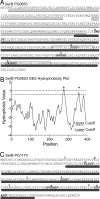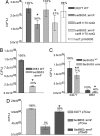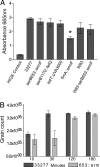A Porphyromonas gingivalis haloacid dehalogenase family phosphatase interacts with human phosphoproteins and is important for invasion
- PMID: 16832066
- PMCID: PMC1544168
- DOI: 10.1073/pnas.0509813103
A Porphyromonas gingivalis haloacid dehalogenase family phosphatase interacts with human phosphoproteins and is important for invasion
Abstract
Haloacid dehalogenase (HAD) family phosphatases are widespread in prokaryotes and are generally involved in metabolic processes. Porphyromonas gingivalis, an invasive periodontal pathogen, secretes the HAD family phosphoserine phosphatase SerB653 when in contact with gingival epithelial cells. Here we characterize the structure and enzymatic activity of SerB653 and show that a SerB653 allelic replacement mutant of P. gingivalis is deficient in internalization and persistence in gingival epithelial cells. In contrast, mutation of a second HAD family serine phosphatase of P. gingivalis (SerB1170), or of a serine transporter, did not affect invasion. A pull-down assay identified GAPDH and heat-shock protein 90 as potential substrates for SerB653. Furthermore, exogenous phosphatase regulated microtubule dynamics in host cells. These data indicate that P. gingivalis has adapted a formerly metabolic enzyme to facilitate entry into host cells by modulating host cytoskeletal architecture. Our findings define a virulence-related role of a HAD family phosphatase and reveal an invasin of an important periodontal pathogen.
Conflict of interest statement
Conflict of interest statement: No conflicts declared.
Figures






Similar articles
-
Identification of 3-acyl-2-phenylamino-1,4-dihydroquinolin-4-one derivatives as inhibitors of the phosphatase SerB653 in Porphyromonas gingivalis, implicated in periodontitis.Bioorg Med Chem Lett. 2012 Mar 1;22(5):2084-8. doi: 10.1016/j.bmcl.2012.01.011. Epub 2012 Jan 21. Bioorg Med Chem Lett. 2012. PMID: 22326397
-
Porphyromonas gingivalis SerB-mediated dephosphorylation of host cell cofilin modulates invasion efficiency.Cell Microbiol. 2012 Apr;14(4):577-88. doi: 10.1111/j.1462-5822.2011.01743.x. Epub 2012 Feb 2. Cell Microbiol. 2012. PMID: 22212282 Free PMC article.
-
Role of Porphyromonas gingivalis phosphoserine phosphatase enzyme SerB in inflammation, immune response, and induction of alveolar bone resorption in rats.Infect Immun. 2010 Nov;78(11):4560-9. doi: 10.1128/IAI.00703-10. Epub 2010 Aug 30. Infect Immun. 2010. PMID: 20805334 Free PMC article.
-
Molecular interaction of Porphyromonas gingivalis with host cells: implication for the microbial pathogenesis of periodontal disease.J Periodontol. 2003 Jan;74(1):90-6. doi: 10.1902/jop.2003.74.1.90. J Periodontol. 2003. PMID: 12593602 Review.
-
Human HAD phosphatases: structure, mechanism, and roles in health and disease.FEBS J. 2013 Jan;280(2):549-71. doi: 10.1111/j.1742-4658.2012.08633.x. Epub 2012 Jun 13. FEBS J. 2013. PMID: 22607316 Review.
Cited by
-
Serum antibody levels against Porphyromonas gingivalis in patients with and without rheumatoid arthritis - a systematic review and meta-analysis.Clin Oral Investig. 2017 Jan;21(1):33-42. doi: 10.1007/s00784-016-1938-5. Epub 2016 Aug 25. Clin Oral Investig. 2017. PMID: 27561661
-
Interactome of Glyceraldehyde-3-Phosphate Dehydrogenase Points to the Existence of Metabolons in Paracoccidioides lutzii.Front Microbiol. 2019 Jul 9;10:1537. doi: 10.3389/fmicb.2019.01537. eCollection 2019. Front Microbiol. 2019. PMID: 31338083 Free PMC article.
-
In silico functional and structural characterization revealed virulent proteins of Francisella tularensis strain SCHU4.Mol Biol Res Commun. 2022 Jun;11(2):73-84. doi: 10.22099/mbrc.2022.43128.1719. Mol Biol Res Commun. 2022. PMID: 36059929 Free PMC article.
-
Porphyromonas gingivalis-nucleoside-diphosphate-kinase inhibits ATP-induced reactive-oxygen-species via P2X7 receptor/NADPH-oxidase signalling and contributes to persistence.Cell Microbiol. 2013 Jun;15(6):961-76. doi: 10.1111/cmi.12089. Epub 2013 Jan 9. Cell Microbiol. 2013. PMID: 23241000 Free PMC article.
-
Targeting the Serine Pathway: A Promising Approach against Tuberculosis?Pharmaceuticals (Basel). 2019 Apr 30;12(2):66. doi: 10.3390/ph12020066. Pharmaceuticals (Basel). 2019. PMID: 31052291 Free PMC article.
References
-
- Burt B. J. Periodontol. 2005;76:1406–1419. - PubMed
-
- Lamont R. J., Yilmaz O. Periodontology 2000. 2002;30:61–69. - PubMed
-
- Nakhjiri S. F., Park Y., Yilmaz O., Chung W. O., Watanabe K., El-Sabaeny A., Park K., Lamont R. J. FEMS Microbiol. Lett. 2001;200:145–149. - PubMed
-
- Chen W., Laidig K. E., Park Y., Park K., Yates J. R., 3rd, Lamont R. J., Hackett M. Analyst. 2001;126:52–57. - PubMed
Publication types
MeSH terms
Substances
Grants and funding
LinkOut - more resources
Full Text Sources
Other Literature Sources
Molecular Biology Databases
Research Materials

